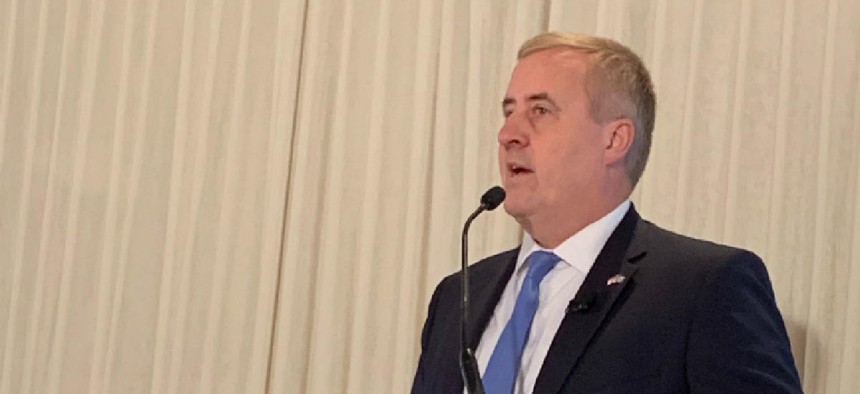VA's pivot to agile

With 10 months on the job, Veterans Affairs CIO Jim Gfrerer is pushing his organization toward a culture of constant delivery.

The MISSION Act, a bipartisan push to expand veterans' benefits to include community care, urgent care, benefits for long-term caregivers and more, was signed into law in June 2018. It puts the onus on the technology team at the Department of Veterans Affairs to assemble a set of online tools to help determine who qualifies for the new benefits and to speed their delivery.
The timeline for rolling out the first wave of MISSION Act benefits was compressed due to the demands of the legislation. Lawmakers were watching closely, in part because of a recent high-profile technology failure at VA to build a tool to calculate and pay new education benefits under the Forever G.I. Bill.
Jim Gfrerer, a former Marine combat officer with 28 years of service, was tapped to lead the Office of Information and Technology (OI&T) at VA -- one of the few CIO posts to require confirmation. He was thrown into the fire at his confirmation hearing in September 2018, when the chairman and ranking member of the Veterans Affairs Committee fumed about the problems with the Forever G.I. Bill tech.
Gfrerer was confirmed by the Senate in January 2019 and immediately had to take charge of rolling out the MISSION Act functionality on a tight timeline.
"I can tell you back in January when we had to deliver by June 6, we were in a highly competitive environment," Gfrerer told FCW in an interview. "We were essentially trying to deliver what would normally take about 12 to 18 months of development in about four or five months. So the way we did that was very strict adherence to agile, delivering around a minimum viable product."
In April 2019, Gfrerer assured a panel of suspicious lawmakers that one key piece of technology -- the Decision Support Tool associated with the community care benefits of the MISSION Act -- would be up and running on the go-live date specified in the legislation.
The Decision Support Tool, Gfrerer explained, was "developed by clinicians for clinicians" and is designed to pull together data from multiple legacy VA systems to help navigate and parse the complicated drive-time and wait-time requirements and specialty needs that determine whether a veteran qualifies for community care under the new law.
Gfrerer says the team delivered version 1.0 in time for training and testing in May. Since June 6, they've had 2.8 million sessions and approximately 26,000 users a day in the cloud-based application with a 99.99% uptime. The application itself is updated on a weekly basis.
"You can see, I think, where using cloud, using agile and focusing on the business, we've delivered a highly stable platform that enables that [patient-clinician] conversation around those new entitlements," Gfrerer said.
The MISSION Act features an expansion of the caregiver benefit, under which individuals including family members giving long-term care to veterans can qualify for stipends and travel and transportation compensation. OI&T is using the expansion -- the benefit was previously available to those caring for veterans injured in post-9/11 conflicts -- to redo the technology underpinning the program. Under Gfrerer, VA abandoned a home-grown solution to go with a commercial, off-the-shelf customer relationship management tool. VA rolled out Phase One of the caregiver program this month, and in January, under Phase Two, the stipend process will be automated. By summer 2020, Gfrerer said, the program will be certified for further expansion.
Also under the MISSION Act, VA plans to aggressively track opioid prescriptions to veterans as part of a drug monitoring program. That program is designed to give VA clinicians visibility into the prescriptions veterans receive outside the VA system, including those from the Defense Department's TRICARE program as well as through commercial and community health systems.
"Our clinicians need the data to be able to see where veterans are getting prescription medications and to make sure that they're not overprescribing or enabling abuse," Gfrerer explained. "So we're going to be delivering on a prescription drug monitoring program in the coming year as well."
Centralization and workforce
Information technology at VA is a little different. Not only is the CIO nominated by the president and confirmed by the Senate, but OI&T has its own budget line (about $5.4 billion in 2019) and is charged with serving all the organizations inside VA -- health, benefits and cemeteries.
"When you look at the efficiency and opportunity to create a much better infrastructure for IT service across the department, it's much better to have a centralized program that services the entire enterprise," Gfrerer said. "We put enterprise in everything we do."
Gfrerer offered the example of a robotics process automation solution for a mail intake program at one of the VA's big administrative departments. Other administrations had the same need, but Gfrerer was able to put out an enterprise-level contract to fulfill those requirements and save millions of dollars over doing one-off contracts. "This is something you wouldn't be able to do if you had decentralized IT," he said.
NEXT STORY: Quick Hits



